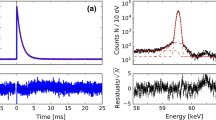Abstract
High-resolution gamma spectrometry was used to study characteristics of californium neutron sources—age, isotopic composition and impurity radionuclides, as well as the effect of the isotopic composition on uncertainties involved in age determination. These characteristics are relevant during criminal investigations related to californium sources found outside of regulatory control. Age determination relies on measuring the activity ratios of long-lived and short-lived fission products of 250Cf and 252Cf. It is based on a known method but also introduces new pairs of isotopes that can be used for this purpose. The isotopic composition was estimated from the direct measurement of the activities of 249Cf and 251Cf isotopes. The methods were tested using 5 californium reference sources at JRC-Karlsruhe. Additional raw data (gamma spectra) were provided by the German Radiation Protection Authority, and by the University of Novi Sad, Serbia. It has been shown that gamma spectrometry can be successfully used to characterize californium sources for nuclear forensic purposes.








Similar content being viewed by others
References
Radev R, McLean T (2014) Neutron sources for standard-based testing. LLNL-TR-664160
Keller OL (1986) Californium-252: properties and production. Nucl Sci Appl 2:263–271
Melnik MI, Karelin EA, Filimonov VT (2002) Production of extra pure curium und californium preparations. In: 14th radiochemical conference, Czech Republic
Burns JD, Van Cleve SM, Smith EH, Boll RA (2015) Californium purification and electrodeposition. J Radioanal Nucl Chem 305(1):109–116
Boll RA et al (2015) Californium electrodepositions at Oak Ridge National Laboratory. J Radioanal Nucl Chem 305(3):921–926
Gehrke RJ, Aryaeinejad R, Hartwell JK, Yoon WY, Reber E, Davidson JR (2004) The γ-ray spectrum of 252Cf and the information contained within it. Nucl Instrum Methods Phys Res B 213:10–21
Gregor J, Kesten J, Kroeger EA, Baron M, Eisheh J-T (2018) Nuclear forensics information obtained from the γ-ray spectra of 252Cf sources of differing provenance. Nucl Instrum Methods Phys Res B 437:13–19
Sima O, Arnold D, Dovlete C (2001) GESPECOR: a versatile tool in gamma-ray spectrometry. J Radioanal Nucl Chem 248(2):359–364
Menlove HO (1991) Neutron coincidence instruments and applications, passive nondestructive assay of nuclear materials. NUREG/CR-5550, LA-UR-90-732 US Nuclear Regulatory Commission, Washington, DC
http://www.nucleide.org/DDEP_WG/DDEPdata.htm. Accessed 5 Nov 2017
Chapman J, Croft S (2017) The use of 252Cf for calibrating safeguards monitors. www.canberra.com/literature/waste_special_systems/tech_papers/Cf-252Cali-paper.pdf. Accessed 2 Nov 2017
Thomas D et al (2017) Recent developments in neutron metrology at the National Physics Laboratory. www.bipm.org/cc/CCRI(III)/Allowed/16/CCRI(III)05-08.pdf. Accessed 2 Nov 2017
Gabeskiria VYa et al (2017) Estimation of the transuranium element yield during irradiation of Pu in the CM-2 reactor central channel (in Russian) (1971). www.iaea.org/inis/collection/NCLCollectionStore/_Public/03/023/3023199.pdf. Accessed 2 Nov 2017
GammaW Software, W. Westmeier, Ebsdorfergrund-Molln (2007) version 18.3
Klochkov EP, Risovany VD (1999) Ulitization of europium-containing control rods by development of gamma europium sources. In: Sarkisov AA, du Clos AT (eds) Analysis of risks associated with nuclear submarine decommissioning, dismantling and disposal. NATO Science Series (Series 1. Disarmament Technologies), vol 24. Springer, Dordrecht
http://www.iaea.org/inis/collection/NCLCollectionStore/_Public/33/026/33026493.pdf. Accessed 19 July 2018
Acknowledgements
This work represents the end result of research carried out during the IAEA Residential Assignment hosted by JRC Karlsruhe. Andrei Apostol expresses his deep appreciation to these two organizations, and, in particular, to the people involved. Special acknowledgement shall be given to Mr. Timofey Tsvetkov, Mr. David Kenneth Smith, Ms. Maria Rieder and Ms. Nicola Vorhofer of the IAEA. Special thanks to Mr. Michael R. Curry of the US State Department and Mr. Vitaly Fedchenko of SIPRI for their support. The authors would also like to thank the German Bundesamt für Strahlenschutz (BfS) for providing gamma spectra and certificates of their 252Cf neutron sources.
Author information
Authors and Affiliations
Corresponding author
Additional information
Publisher's Note
Springer Nature remains neutral with regard to jurisdictional claims in published maps and institutional affiliations.
Rights and permissions
About this article
Cite this article
Apostol, A.I., Zsigrai, J., Bagi, J. et al. Characterization of californium sources by gamma spectrometry: relevance for nuclear forensics. J Radioanal Nucl Chem 321, 405–412 (2019). https://doi.org/10.1007/s10967-019-06628-0
Received:
Published:
Issue Date:
DOI: https://doi.org/10.1007/s10967-019-06628-0




